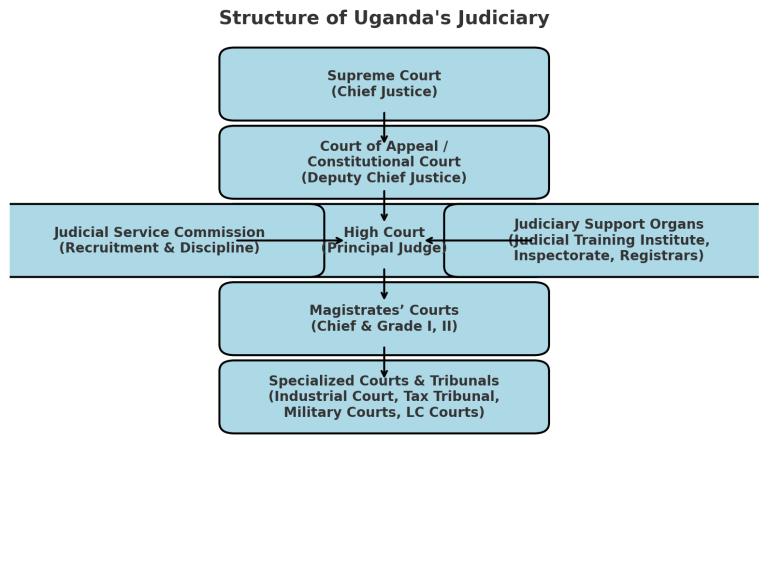The Uganda Judiciary Structure forms one of the three arms of government, alongside the Executive and Legislature. Established under the 1995 Constitution (Chapter Eight), it is mandated to interpret laws, administer justice, and protect citizens’ rights. The Judiciary operates in a hierarchical system designed to ensure efficiency, independence, and accountability in the delivery of justice.
Head of the Judiciary
The Judiciary is led by the Chief Justice, the highest judicial officer in Uganda. The Chief Justice chairs the Supreme Court, oversees judicial policy, and is assisted by the Deputy Chief Justice, who heads the Court of Appeal/Constitutional Court and steps in when the Chief Justice is unavailable.
Courts of Judicature
Uganda’s courts are organized in a pyramidal hierarchy, with powers defined by the Constitution and the Judicature Act.
Supreme Court – The highest court of appeal, handling presidential election petitions, constitutional matters, and cases of national importance. It is headed by the Chief Justice and consists of up to 11 Justices, usually sitting in panels of 5 or 7.
Court of Appeal / Constitutional Court – The second-highest court, hearing appeals from the High Court. It functions as the Constitutional Court in matters of constitutional interpretation and is headed by the Deputy Chief Justice.
High Court – Holds unlimited original jurisdiction in civil and criminal cases and supervises Magistrates’ Courts. It is divided into specialized divisions for efficiency: Civil, Criminal, Commercial, Land, Family, Anti-Corruption, and International Crimes, and is headed by the Principal Judge.
Magistrates’ Courts – Governed by the Magistrates’ Courts Act, they handle most civil and criminal cases at first instance. These courts are categorized as Chief Magistrates’ Courts (wider jurisdiction), Grade I (limited jurisdiction), and Grade II (minor cases).
Specialized and Other Courts
Several specialized courts handle specific matters:
- Industrial Court – Resolves labor disputes.
- Local Council Courts (LC Courts) – Address community-level disputes and minor cases.
- Tribunals – Created by Parliament, including tax appeal and military tribunals.
Judicial Service Commission (JSC)
The JSC is an independent body responsible for recruiting, disciplining, and advising the President on judicial appointments. It safeguards the independence and accountability of the Judiciary.
Supporting Organs
Supporting institutions ensure the smooth functioning of the Judiciary:
- Judicial Training Institute – Provides professional development for judges and magistrates.
- Judiciary Administration – Manages finances, infrastructure, and day-to-day operations.
- Inspectorate of Courts – Monitors discipline, integrity, and accountability of judicial officers.
Key Judicial Officers
- Chief Registrar – Chief accounting officer and head of court registries.
- Registrars, Deputy Registrars, Assistant Registrars – Manage records, cause lists, and case flow.
- Magistrates – Deliver justice at the grassroots.
- Justices of the Peace – Appointed laypersons handling community-level matters.
In summary, Uganda’s Judiciary is structured as a pyramidal system, with the Supreme Court at the top, followed by the Court of Appeal/Constitutional Court, the High Court, and Magistrates’ Courts at the base. Supporting bodies like the Judicial Service Commission and Judicial Training Institute ensure its independence, professionalism, and effective administration of justice.

